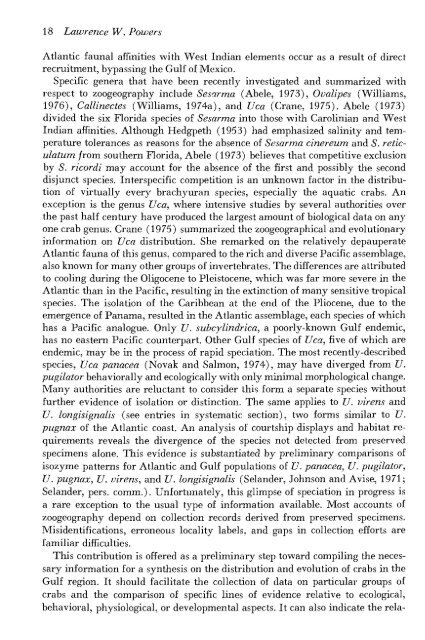Create successful ePaper yourself
Turn your PDF publications into a flip-book with our unique Google optimized e-Paper software.
18 Lawrence W. Powers<br />
Atlantic faunal affinities with West Indian elements occur as a result of direct<br />
recruitment, bypassing the Gulf of Mexico.<br />
Specific genera that have been recentlj' investigated and summarized with<br />
respect to zoogeography include Sesarma (Abele, 1973), Ovalipes (Williams,<br />
1976), CalUnectes (Williams, 1974a), and Uca (Crane, 1975). Abele (1973)<br />
divided the six Florida species of Sesarma into those with Carolinian and West<br />
Indian affinities. Although Hedgpeth (1953) had emphasized salinity and temperature<br />
tolerances as reasons for the absence of Sesarma cinereum and S. reticulatum<br />
from southern Florida, Abele (1973) believes that competitive exclusion<br />
by S. ricordi may account for the absence of the first and possibly the second<br />
disjunct species. Interspecific competition is an unknown factor in the distribution<br />
of virtually everj'' brachj^uran species, especially the aquatic crabs. An<br />
exception is the genus Uca, where intensive studies by several authorities over<br />
the past half century have produced the largest amount of biological data on anj'<br />
one crab genus. Crane (1975) summarized the zoogeographical and evolutionary<br />
information on Uca distribution. She remarked on the relatively depauperate<br />
Atlantic fauna of this genus, compared to the rich and diverse Pacific assemblage,<br />
also known for many other groups of invertebrates. The differences are attributed<br />
to cooling during the Oligocene to Pleistocene, which was far more severe in the<br />
Atlantic than in the Pacific, resulting in the extinction of many sensitive tropical<br />
species. The isolation of the Caribbean at the end of the Pliocene, due to the<br />
emergence of Panama, resulted in the Atlantic assemblage, each species of which<br />
has a Pacific analogue. Only U. subcylindrica, a poorly-known Gulf endemic,<br />
has no eastern Pacific counterpart. Other Gulf species of Uca, five of which are<br />
endemic, may be in the process of rapid speciation. The most recentlj^-described<br />
species, Uca panacea (Novak and Salmon, 1974), may have diverged from U.<br />
pugilator behaviorally and ecologically with only minimal morphological change.<br />
Many authorities are reluctant to consider this form a separate species without<br />
further evidence of isolation or distinction. The same applies to U. virens and<br />
U. longisignalis (see entries in systematic section), two forms similar to U.<br />
pugnax of the Atlantic coast. An analysis of courtship displays and habitat requirements<br />
reveals the divergence of the species not detected from preserved<br />
specimens alone. This evidence is substantiated by preliminary comparisons of<br />
isozyme patterns for Atlantic and Gulf populations of U. panacea, U. pugilator,<br />
U. pugnax, U. virens, and U. longisignalis (Selander, Johnson and Avise, 1971;<br />
Selander, pers. comm.). Unfortunately, this glimpse of speciation in progress is<br />
a rare exception to the usual tj^pe of information available. Most accounts of<br />
zoogeography depend on collection records derived from preserved specimens.<br />
Misidentifications, erroneous locality labels, and gaps in collection efforts are<br />
familiar difficulties.<br />
This contribution is offered as a preliminary step toward compiling the necessary<br />
information for a synthesis on the distribution and evolution of crabs in the<br />
Gulf region. It should facilitate the collection of data on particular groups of<br />
crabs and the comparison of specific lines of evidence relative to ecological,<br />
behavioral, physiological, or developmental aspects. It can also indicate the rela-

















